The microbiological quality of curd cheese prepared in northeastern Brazil and sold in street markets and supermarkets in the towns of Feira de Santana and Cruz das Almas BA Brazil, was evaluated for mesophyllic and psycrotrophic count, molds and yeasts, total coliforms and E. coli, and the occurrence of E. coli O157. Sixty-eight curd cheese samples were collected between February and June 2014 and the analysis for each microorganism was based on Norm N. 62 published in August 26, 2003 by the Ministry of Agriculture, Livestock and Supply (MAPA), according to successive dilutions, time and temperature of each organism. Counting of colonies was expressed as colony-forming units per ml of sample (UFC / mL). Escherichia coli O157 were transferred to the Singlepath E. coli O157 test from the culture medium MEC Broth with Novobiocin. The curd cheese revealed 100% contamination by mesophyllic microorganisms, 51.47% by psycrotrophic, 98.53% by yeasts and molds, 88.24% by coliforms, 77.94% by E. coli and 22% by E. coli O157 serotype. Curd cheese sold in the street market and in supermarkets in Feira de Santana and Cruz das Almas proved to have been prepared under unsatisfactory hygienic conditions, endangering the health of consumers and featuring contamination rates above those permitted by law.
Foodborne diseases are still one of the major public health problems world wide and account for considerably high cases of illness. Recent reports indicate that Staphylococcus aureus, Salmonella spp., Listeria monocytogenes and pathogenic Escherichia coli are considered the most frequent pathogens and they are responsible for outbreaks mainly associated with raw milk and raw or inadequately heated milk products (Ahmed and Shimamoto, 2014; Feitosa et al., 2003; Fernandes et al., 2006; Oliveira et al., 2014).
The main reservoir of this pathogen appears to be wild and domestic ruminants such as deer, cattle, goats and sheep. In addition to undercooked beef hamburgers and other meat products, as well as water, fruits and vegetables, cheeses made from raw milk have been implicated in infections of E. coli O157:H7 (Brasil, 2003; Mora et al., 2007; Moreno et al., 2002; Oliveira et al., 2012; Öksüz et al., 2004). Since dairy cattle are asymptomatic carriers of E. coli O157:H7, meat and milk products are thought to be risky foods from the point of view of this organism. Therefore, insufficient heat-treatment of ground meat and raw milk forms a potential infection risk. The processing conditions for different milk products are very important from the standpoint of the organisms infection risk. Although, it can be destroyed with pasteurisation, the survival rate in other processes is high, for example it can tolerate 8.5% salt concentration. Cheese made with unpasteurised milk is potential vehicle for transmission of E. coli O157 to the consume (Oliveira et al., 2012, 2014; Otero et al., 2014).
Despite the risk presented by E. coli O157:H7 in dairy products, there are few studies on the incidence of this microorganism in Brazil. The current analysis evaluates the microbiological quality of curd cheese commercialized in street markets and in supermarkets of Feira de Santana and Cruz das Almas BA Brazil, by counts of mesophyll and psycrotrophic microorganisms, molds and yeasts, total coliforms, E. coli and E. coli O157.
Sixty-eight curd cheese samples were collected from the street market and supermarkets of Feira de Santana and Cruz das Almas, in the northeastern state of Bahia, Brazil, between February and June 2014. The samples were retrieved in aseptic conditions and transported in an isothermal container with recycled ice and maintained under refrigeration till laboratory analyses at the Animal Microbiology and Parasitology of the Universidade Federal do Recôncavo da Bahia UFRB, Cruz das Almas BA Brazil.
Microbiological analyses were conducted following recommendations and requirements by RDC n. 12 of 2/1/2001 (Blanco et al., 2003; Brasil, 2001a). The methodology for microbiological analyses was foregrounded on Norm 62 of 26/8/2003 of the Brazilian Ministry of Agriculture, Livestock and Supply (MAPA) which provided the official analytic methods for the microbiological analyses for the control of animal-derived products and water (Brasil, 2001a, b, c).
The microbiological analyses performed were: counts of mesophyll and psycrotrophic microorganisms, filamentous fungi (molds) and yeasts, total coliforms, E. coli and confirmation of E. coli O157.
Plate count agar (PCA) culture was employed to count viable strict and facultative aerobic mesophyll and psycrotrophic microorganism. Cultures were incubated in a culture buffer and fridge according to the time and temperature of each microorganism. Filamentous fungi (molds) and yeasts counts were undertaken with Dextrose Sabourand Agar culture medium incubated in a BOD-like buffer. The colonies for each microorganism were counted and multiplied by the corresponding dilution factor and the result given as colony-forming units per mL of the sample (CFU/mL) (Ahmed and Shimamoto, 2014; Apha, 1998).
Total coliform and E. coli were counted in Chromocult Coliform Agar culture medium and incubated in a culture buffer. The simultaneous detection of total coliforms and E. coli was undertaken with a combination of two types of chromogenic substrates. The salmon substrate β-D-GAL was cleaved by the enzyme β-D-galactosidase, characteristic of other coliforms, resulting in colonies with salmon to red coloration. The X-β-D-glucuronide substrate was cleaved by β-D-glucuronidase enzyme, characteristic of E. coli, resulting in colonies with dark blue to violet coloration (ISO 7218:1996 / 1:2001). E. coli O157 was identified by the immunochromatographic fast test to detect E. coli O157 (SINGLEPATH E. COLI O157 EMB. C/25 TESTES MERCK) (Ahmed and Shimamoto, 2014; Apha, 1998).
Brain heart infusion (BHI) broth was used for the propagation and maintenance of E. coli colonies which, after inoculation and incubation in a buffer, were placed on Petri plates with Nutrient Agar culture medium for conservation and maintenance. The cultures were maintained under refrigeration for 5 months till collection was concluded. Colonies from the nutrient agar were then inoculated in MEC broth with Novobiocine (MERCK) and incubated (Ahmed and Shimamoto, 2014). They were later transferred to Singlepath E. coli O157 test, a fast immunochromatic test for the detection of E. coli O157, with a circular sampling point, with the oval form as test (T) and control (C) zones. When a drop from the MEC broth culture with Novobiocine is placed, the assay works correctly if a red line appears on the control zone (C) within 20 min. The sample is thus positive for E. coli O157 if prior to 20 min the red lines appear in the two zones (T and C). The sample is negative when no red line appears on the test zone and it fails to appear clearly on the control zone (C) during 20 min after the application of the sample.
Microbiological data were transformed into log UFC/g. Minimum rate, maximum rate, arithmetic average, variance, coefficient of variation were performed by absolute and percentage distribution for nominal variables and statistical measures. Tukey’s test verified the significant difference in the detection of microorganisms at the different collection sites.
Contamination rates on the street market and in supermarkets of Feria de Santana and Cruz das Almas were similarly measured by the analysis of variance for mesophyll and psycrotrophic microorganisms, fungus molds and yeasts, total coliforms and E. coli. Although means did not differ statistically (p<0.01), or rather, at 1% significance, Tukey´s test was applied to compare averages between the treatments. Absolute rates of the samples exhibited the same letter.
Table 1 demonstrates that the differences in the coefficient of variation (CV) occurred for total coliforms among the samples from the two towns. Feria de Santana (FSA – SM) had CV equal to 35.32%, followed by 16.89% for FSA - S, whereas in Cruz das Almas, CV were 25.34% and 11.15% respectively for CA – SM and CA - S. Therefore, curd cheese in the supermarkets of Cruz das Almas (CA - S) had more homogeneous rates as compared to samples from other collection places under analysis. However, standard deviation (SD) of samples from the supermarkets of Cruz das Almas (CA - S) had the lowest rate (0.60) and thus revealed that differences were not so big.
Although in the case of E. coli, rates on the street market in Feira de Santana (FSA - SM) had a lower CV (21.90%), the samples of the street market of Cruz das Almas had the lowest standard deviation (SD) or rather, 0.66. The above revealed that its samples were more homogeneous when compared with those from other sampling sites.
S. aureus and E. coli in cheese are frequently used as indicators of hygienic quality and show lack of microbiological safety. Some strains of these organisms are known to cause diseases in humans. Therefore, they are undesirable in high number (Otero et al., 2014; Öksüz et al., 2004; Salotti et al., 2006).
The microbiological evaluations of curd cheese revealed microorganism counts which indicated total coliforms and E. coli; deteriorating microorganisms such as mesophylls and psycrotrophic microorganisms, molds and yeasts; and pathogenic microorganisms such as E. coli O157, given in Figures 1 - 5 and Tables 2 and 3.

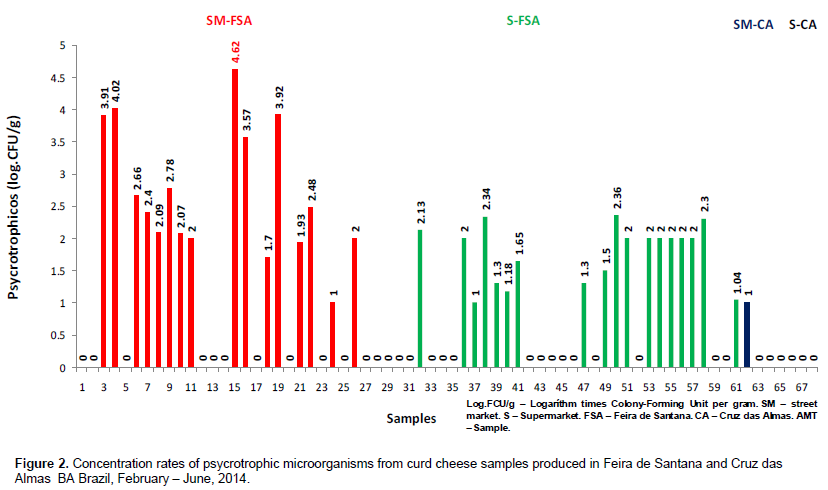

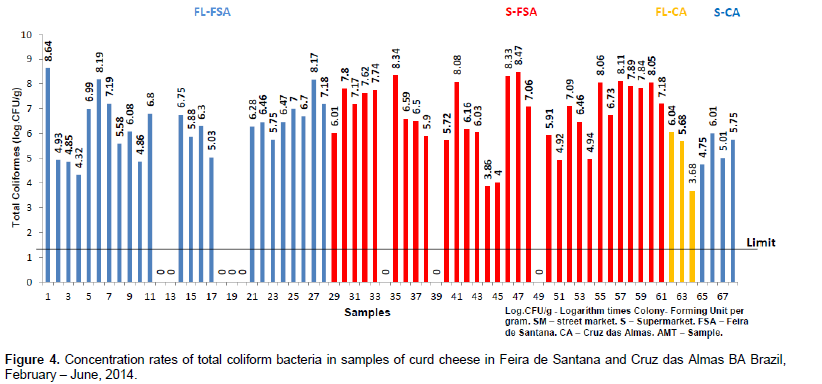
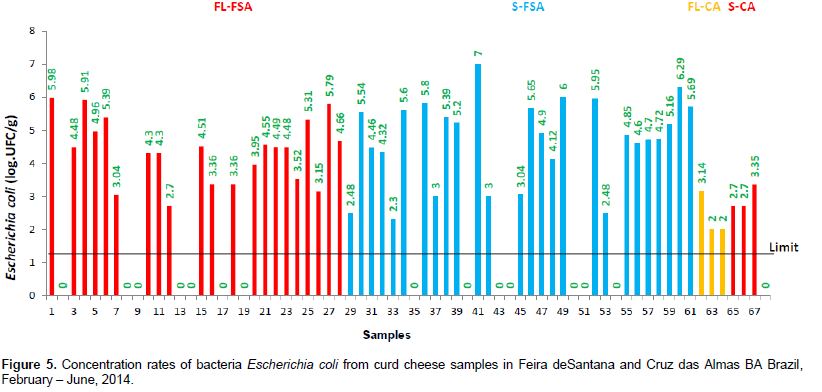
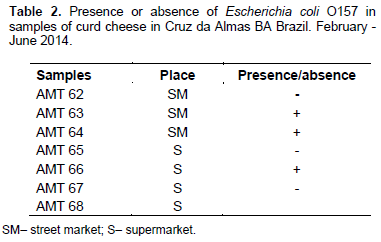
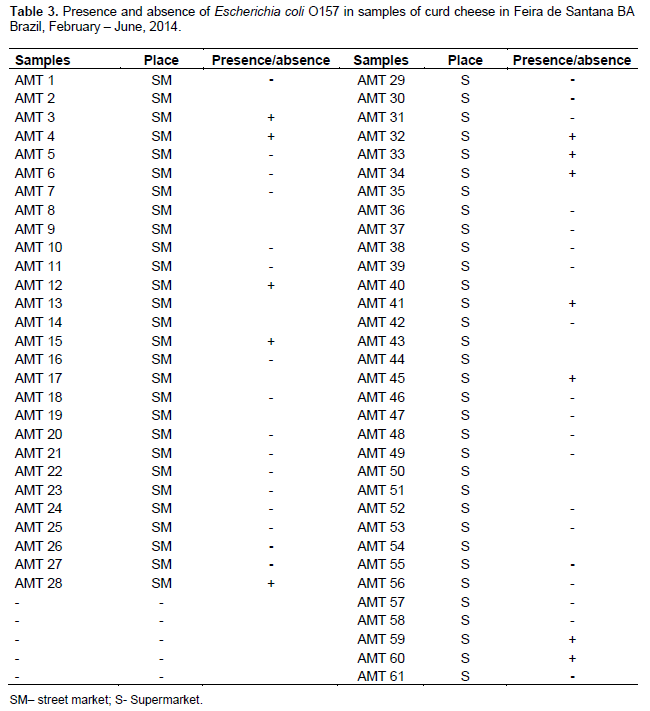
All the microorganisms under analysis showed 100% contamination by mesophyll microorganisms; 51.47% by psycrotrophic microorganisms; 98.53% by molds and yeasts; 88.24% by total coliforms; 77.94% by E. coli; 22% by serum type E. coli O157. The intake of curd cheese with the above improper conditions may have serious consequences in the population and thus, public health is involved. According to RDC n. 12, the minimum limit is the acceptable lot of the product, whilst the maximum limit separates the acceptable from the non-acceptable product. Intermediate rates between the maximum and minimum limits are products of intermediate acceptable rates making mandatory the hygiene conditions in the processing of the products (Blanco et al., 2003; Brasil, 2001a).
The curd cheese analyzed in the two towns had mesophyll bacteria counts between 4.32 and 13.05 log CFU/g (Figure 1). Curd cheese samples were exposed on the trays of the street markets and in supermarkets, without any proper hygiene, causing the contamination.
Count rates of mesophyll bacteria in the current experiment revealed only two samples with 4.32 and 4.97 log FCU/g and thus within the limits recommended by ANVISA, following RDC n. 12 of 2/1/2001, which accepts mesophyll microorganisms up to 5 log FCU/g (Blanco et al., 2003; Brasil, 2001a, b, c).
High mesophyll rates in food indicate that they were prepared with highly contaminated raw matter, that processing was unsatisfactorily from sanitary aspects and that food was stored in inadequate time and temperature conditions. However, high levels of mesophyll bacteria were not used to analyze the sanitary conditions of fermented lactic products in which microorganisms are used in the processing (Kousta et al., 2010).
When compared with the mesophyll microorganism rates, the psycrotrophic microorganisms had lower rates, or rather, between 1 and 4.62 log CFU/g (Figure 2). Only one sample among the samples analyzed for Cruz das Almas was contaminated with 1 log CFU/g, whereas Feira de Santana had 55.7% of samples with the bacterium. Brazilian legislation fails to delimit psycrotrophic microorganisms in milk products. Microbiological contamination caused by processing and/or storage flaws may have contaminated the product, coupled with its organoleptic characteristics (taste, aroma, color and texture) (Apha, 1998).
With the exception of AMT 17, molds and yeasts were detected in curd cheese (Figure 3). The other samples were above the tolerance limit of 2 log CFU/g recommended by RDC n. 12 of 2/1/2001. According to Lourenço and Sousa (2001) analyses on samples of curd cheese from Marajó, Brazil, produced from buffalo and cow milk showed a rate >3 log UFC/g for the same microorganism.
Samples of curd cheese in Feira de Santana showed between 4.23 and 11.88 log CFU/g, whereas in Cruz das Almas the rates ranged between 8.27 and 9.41 log CFU/g. Mold and yeast rates in curd cheese revealed contamination in the product and thus health risks to the consumer, due to higher rates than those established by sanitary legislation. Re-contamination of curd cheese may occur during handling in the final processing and in storage. Since some molds are psycrotrophic, their spores survive and germinate in favorable conditions. Refrigeration temperature inhibits mold development but they are incapable of destroying them. Anaerobiosis may improve the product´s conservation (Loguercio et al., 2001).
Figures 4 and 5 show log CFU/g rates of total coliforms and E. coli, with 11.76 and 22% of the 68 samples under analysis within the tolerance margin; the other samples revealed <1 log CFU/g of total coliforms (Brasil, 2001). According to Salotti et al. (2006), the human intestine and that of other animals is the habitat of this bacterium group. Incorrect handling and faulty application of procedures of good manufacture practice are involved when it occurs in food. It is thus indicative of fecal contamination with health risks to consumers due to its association with pathogenic microorganisms. Kousta et al. (2010) underscore that the presence of these microorganisms in cheese evidences pasteurization flaws or post-pasteurization contamination due to the fact that correct pasteurization eliminates all indicator and pathogen microorganisms.
The presence of 100% total coliforms, with counts ranging between 3.68 and 6.04 log UFC/g, occurred for curd cheese in Cruz das Almas. E. coli was not merely detected in one sample; since the others were above the limit established by Brazilian legislation, unsatisfactory sanitary hygiene conditions were rampant.
Analyses showed that most curd cheese comercialized failed to have the required conditions for consumption. High contamination index by microorganisms in the curd cheese may have occurred due to faulty prime matter up to an adequate place for selling the product. In fact, all the cheese samples were exposed without any protection or refrigeration, with the consequent survival and multiplication of microorganisms (Mora et al., 2007). Contamination by air is an important issue in product production units whose concern lies in quality control of their products. The air is a vector without any specific flora but has a great amount and variety of suspended microorganisms, or rather, they are maintained in the air by dust and liquid particles (Fernandes et al., 2006).
Cheeses commercialized on street markets and in supermarkets of the two towns manifest unsatisfactory hygiene conditions, with great health risks for the consumer. The effective application of hygiene and sanitization principles recommended for the elaboration of cheese should be undertaken so that consumers may have products featuring acceptable microbiological quality, with a long shelf life.
Varying levels of presumptive E. coli counts in the samples may indicate the extreme diversity of hygienic practices undertaken throughout the milk and cheese productions. The incidence and presumptive E. coli counts are similar to those reported by Kaan and Özdemir (2006), generally made from raw milk, and reveals an extensive deficiency of satisfactory cheese manufacturing and/or post production handling, because these organisms are killed by pasteurization and are found in a wide variety of habitats sanitary practices during milk production (Öksüz et al., 2004; Salotti et al., 2006).
Tables 2 and 3 demonstrate the occurrence of E. coli O157 in curd cheese. E. coli is a pathogenic bacterium with serious repercussions in public health. Fifteen out of the 53 samples contaminated by E. coli were positive for E. coli O157. The percentage is very high since all food should be free from pathogenic microorganisms.
In many developed countries, O157:H7 is the most prevalent STEC serotype associated with severe disease in humans. However, estimation of the prevalence of O157-associated infections in Latin America is difficult since screening for O157 is performed by only a few microbiological laboratories from few countries (Loguercio et al., 2001).
Curd cheese is rich in nutrients and deteriorates fast by microorganisms if not stored properly. Hygiene from the production of prime matter to production, storage, transport and commercialization is basic. Contamination of curd cheese may occur in all these stages. Further, E. coli in food may be assessed under two headings. E. coli may be initially an enterobacterium and indicates fecal microbial contamination and consequently the product was prepared in unsatisfactory hygiene conditions.
Another aspect may be taken into account, that is, E. coli strains are pathogenic for humans and animals (Ahmed and Shimamoto, 2014; Leite Júnior et al., 2000; Loguercio et al., 2001).
The Single path E. coli O157 test, a fast immuno-chromatic test for the detection of E. coli O157, revealed that 15 samples (22%) showed the characteristic presence of the strain (Tables 2 and 3). Seven and eight samples of curd cheese sold on the street market and in the supermarkets of the two towns contained respectively, E. coli O157. This fact is of great concern since EGEC is an important microorganism which causes gastroenteritis in people at the extremes of the age bracket and in immunosuppressed patients (Fernandes et al., 2006). Enterohemorrhagic E. coli (EHEC) is pathogenic for humans and belongs to the shiga toxigenic E. coli (STEC) group (Ahmed and Shimamoto, 2014). It is one of the great causes of gastroenteritis, causing hemorrhagic colitis (HC) or hemolitic uremic syndrome (HUS), the main cause of kidney disease in children. Since its identification as a pathogen in 1982, STEC O157 has been held to be the cause of several diseases, especially in Canada, Japan, UK and US (Aquarone et al., 2001; Bergamini et al., 2007).
Food of animal origin has been identified as the main vehicle for the transmission of foodborne pathogens to humans. Three major foodborne pathogens affecting people worldwide are S. enterica, E. coli O157:H7 and Shigella spp. An overview of foodborne disease reports from seven countries has indicated that milk and milk products were implicated in between and 5% of the total number of bacterial outbreaks. Several large outbreaks of foodborne disease due to the consumption of raw milk cheese have been reported. E. coli O157:H7 can potentially enter the human food chain from a number of animal sources. The presence of these pathogens can be due to contamination taking place during milking at dairy farms or because of poor handling of meat, milk and cheese by retailers (Ahmed and Shimamoto, 2014; Otero et al., 2014; Öksüz et al., 2004).
Curd milk prepared in the northeastern region of Brazil is a very soft cheese, but also an excellent culture medium. Besides its high moisture index, it is rich in nutrients that enhance the growth of microorganisms. Curb cheese is thus easily contaminated by micro-organisms throughout its production process till commercialization. Refrigeration and vacuum packaging may be a strategy to reduce contamination since they delay the deterioration process of the curd cheese exposed during commercialization.
Results show that the samples analyzed for the micro-organisms researched in the current assay do not comply with Brazilian legislation and may be considered as low quality products. The curd cheeses analyzed are improper for intake since contamination causes risk to human health. It is safer to opt for inspected and refrigerated products, wrapped in proper packages, with the date of manufacture, best before date and conditioning.
In Brazil, domestically-produced raw milk cheeses are popular with consumers, so their availability is considerably higher than cheeses made from pasteurized milk. Consequently, educating employees, retailers and consumers on the appropriate handling and storage of meat and dairy products is essential to effectively prevent contamination. Simple intervention strategies, such as promoting hand washing with soap and good hygienic practices at the slaughterhouses, processing plants and retailer shops, can have a sound practical impact on public health. Health education for the general population is required by regulatory authorities where the sale of raw milk and rawmilk products is permitted. A strong science-based approach that addresses all the issues involved in continuing to improve food safety and public health is necessary to prevent foodborne illnesses. The strengthening of food control systems including foodborne disease surveillance and food monitoring is required, especially in developing countries for the prevention, detection and control of foodborne illnesses.